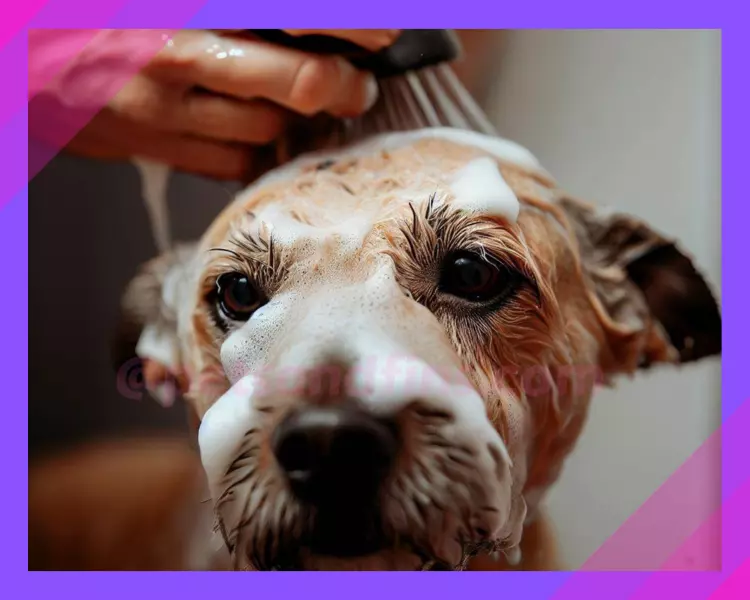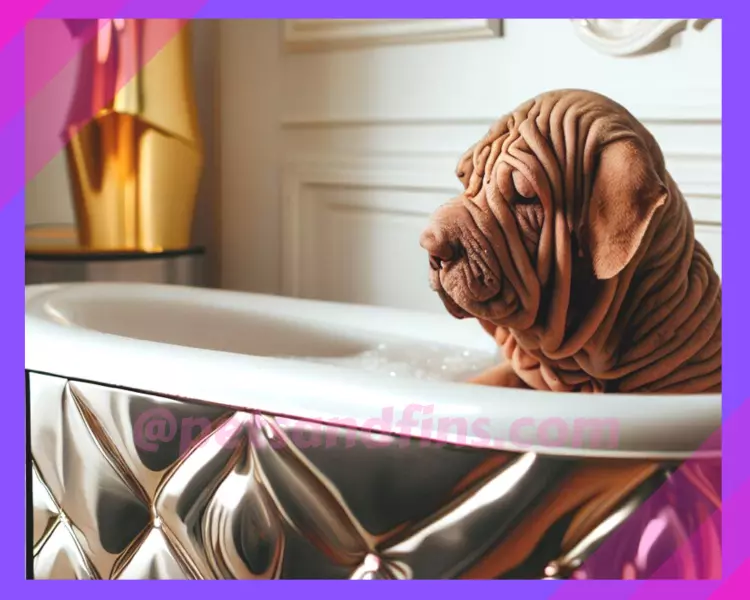One of the most common questions that pet parents ask is “how often should you bathe your dogs”? The answer isn’t as simple as a one-size-fits-all approach, as there are several factors to consider. However, it is important to decide the answer based on your dog, its coat, and lifestyle.
Finding the right balance is crucial when it comes to bathing your dog. Overbathing can strip their coat of natural oils and cause dryness or irritation. On the other hand, under-bathing can lead to health issues such as skin infections.
In this persuasive article, we will explore these factors in-depth and provide insight into how often you should bathe your dog based on their individual needs. Let’s dive in!
Dogs With No Skin Problems– How Often Should You Bathe Your Dog In General?
Dogs with no skin problems do not need to be bathed frequently. Over-bathing can strip away natural oils from their skin which can lead to dryness, irritation, and even infections which may be triggered the dog biting its skin. (due to itching or irritation).
Secondly, frequent bathing can disrupt the balance of bacteria on your dog’s skin. Dogs have a natural microbiome on their skin that helps protect them from harmful bacteria and other pathogens.
Therefore, in general, dogs by following the general rule of once every three months (unless otherwise specified by your vet), using the right shampoo and maintaining good hygiene habits in between baths, you can ensure your dog stays clean and healthy.

Dogs With No Hair
Dogs are one of the most popular pets in the world, and they come in all shapes and sizes. Some dogs have long hair, while others have short hair or no hair at all. Dogs with no hair, such as the Chinese Crested or the Xoloitzcuintli, require more frequent baths than their furry counterparts.
This is because their lack of fur makes them more susceptible to skin irritations and infections.
Without a protective layer of fur, their skin is vulnerable to sunburn, insect bites, and other irritants. Bathing helps remove these irritants from their skin and prevent further damage.
Bacteria and fungi thrive in warm, moist environments like those found on a dog’s skin. When a dog’s natural defenses are compromised by an injury or illness, these microorganisms can cause infections such as dermatitis or ringworm.
Regular bathing can help prevent these infections by removing excess oil and dead skin cells from the surface of the skin. So, “how often should you bathe your dogs”?
Experts’ advice these dogs must be bathed once a week.
Dogs With Short-Hair – How Often Should You Bathe Your Dog?

How often should you wash a short-haired dog is actually a good question. Short-haired dogs, in particular, only need a bath once every six to ten weeks. Here are some reasons why. Short-haired dogs have less fur than their long-haired counterparts, which means they produce less oil overall.
This makes them even more susceptible to dryness if they are bathed too often. In fact, some veterinarians recommend that short-haired dogs be bathed even less frequently than every six weeks.
Bathing your dog too often can actually make them smell worse! This may seem counterintuitive at first, but it’s true – when you strip away their natural oils with frequent baths, their skin tries to compensate by producing even more oil than before.
Dogs With Long Hair –How Often Should You Bathe Your Dog?

As a dog owner, it is important to maintain the hygiene of your furry friend. Dogs with long hair require extra attention when it comes to grooming and bathing. So, “how often should you bathe your dogs”? It is recommended that dogs with long hair should be bathed every four to six weeks.
This may seem like a lot, but there are several reasons why this is necessary.
Firstly, dogs with long hair are more prone to matting and tangling. If left unattended, these mats can become painful for the dog and even lead to skin infections. Regular bathing helps prevent mats from forming by keeping the hair clean and tangle-free.
Secondly, dogs with long hair tend to attract dirt and debris more easily than their short-haired counterparts. This is because their fur provides a perfect hiding place for dirt particles that can cause skin irritation or infection if not removed regularly through bathing.
Thirdly, regular bathing helps keep your dog’s coat shiny and healthy-looking. Long-haired breeds such as Shih Tzus or Afghan Hounds have beautiful coats that require special care. Bathing them every four to six weeks helps maintain their coat’s natural oils which keep it looking shiny and healthy.
Another reason why regular baths are important for dogs with long hair is that they can help prevent allergies in both pets and humans alike. Allergens such as pollen or dust mites can get trapped in a dog’s fur, causing allergic reactions in both the pet and its human family members.
Regular baths help remove these allergens from the dog’s coat before they have a chance to cause any problems. Furthermore, bathing your dog regularly also helps prevent the spread of parasites such as fleas and ticks.
Wrinkly Dog Breeds

Dogs with wrinkly skin require extra attention when it comes to their hygiene as they are prone to skin infections and other health issues. Therefore, it is essential that dogs with wrinkly skin be bathed every week or two.
Wrinkly skinned dogs like Bulldogs, Shar Peis, Pugs, and Basset Hounds have folds of skin that trap dirt and moisture. These folds can become breeding grounds for bacteria if not cleaned regularly.
The bacteria can cause infections such as pyoderma which can lead to severe itching, hair loss, and even fever in some cases. So, “how often should you bathe your dogs”?
Bathing your dog every week or two helps prevent the buildup of dirt and bacteria in their wrinkles. It also helps remove any excess oils on their skin that can cause bad odors. Regular bathing also helps keep your dog’s coat shiny and healthy-looking.
Some people may argue that bathing your dog too often can strip their coat of natural oils leading to dryness and irritation. However, this is not entirely true for dogs with wrinkly skin as they produce more oil than other breeds due to the folds in their skin trapping moisture.
Dogs with wrinkly skin are prone to skin issues such as rashes, hot spots, and allergies. Regular baths allow you to check for any abnormalities in their skin such as redness or inflammation which may indicate a health issue that needs to be addressed.
Working Dogs

Working dogs who are exposed to various environments and situations that can cause them to become dirty and smelly. Therefore, it is crucial that working dogs be bathed on a need basis.
Working dogs are trained to perform specific tasks such as search and rescue, tracking, herding, and hunting. They are often exposed to dirt, mud, water, and other elements that can cause them to become dirty and smelly. Bathing these dogs not only helps maintain their hygiene but also prevents the spread of diseases.
One of the main reasons why working dogs need to be bathed on a need basis is because of their exposure to various environments. For example, search and rescue dogs may be required to enter buildings or areas that have been contaminated with hazardous materials or chemicals. These substances can cling onto the dog’s fur and skin which can cause irritation or even lead to health problems if not washed off properly.
Similarly, hunting dogs may be exposed to ticks or fleas while out in the field. These parasites can latch onto the dog’s fur which can lead to infestations if not treated promptly. Bathing these dogs with flea shampoo or other treatments can help prevent these pests from taking hold.
Another reason why working dogs need regular baths is because of their high activity levels. Working dogs are often highly active breeds such as Border Collies or German Shepherds who require plenty of exercise each day. As they run around outside or engage in physical activities such as agility training, they sweat just like humans do.
Sweating leads to an accumulation of bacteria on their skin which causes bad odors over time if left unattended. Regular bathing helps remove this bacteria buildup along with any dirt or debris that may have accumulated on their fur during playtime.
However, if the working dog is homebound, such as assisting physically challenged people, they may not need bathing as often as dogs who work outside.
Dogs With Health Conditions

When a dog has a health condition, grooming can become more complicated. Naturally, the question arises – “how often should you bathe your dogs”? It is important to follow medical advice when it comes to bathing dogs with health conditions.
Firstly, bathing dogs with skin conditions can help alleviate symptoms and prevent infections. Dogs with allergies or skin irritations may benefit from medicated shampoos that are prescribed by a veterinarian. These shampoos can help reduce itching and inflammation on the skin. Additionally, regular baths can help remove allergens or irritants that may be causing the skin condition.
It is important to note that not all dogs require frequent baths as over-bathing can strip their coat of natural oils which could lead to dryness and irritation of the skin. However, when a dog has a health condition that requires special attention such as allergies or skin issues then regular bathing should be part of their treatment plan.
Following medical advice regarding bathing dogs with health conditions is essential for maintaining their overall well-being and preventing further complications from arising due to poor hygiene practices.
The American Kennel Club Approach

The American Kennel Club (AKC) has taken an interesting approach to this problem by suggesting that we bathe our dogs when we can’t hug them. To quote “At the end of the day, Bendersky offers this advice: “We should wash our dogs when they are no longer huggable.”
[How Often Should You Wash Your Dog? — American Kennel Club (akc.org)]
This approach makes sense because different breeds have different coat types, which require specific care. For example, dogs with thick coats like Huskies or Malamutes need less frequent baths as their coats are self-cleaning and water-resistant. On the other hand, dogs with thin coats like Greyhounds or Whippets need more frequent baths as they have less protection against dirt and grime.
Additionally, a dog’s lifestyle can also affect how often they need to be bathed. Dogs who spend a lot of time outdoors or in water may require more frequent baths than those who live indoors most of the time.
This approach actually triggered my research. The question that naturally arises in all this is “How will i know that my dog is in need of a bath?”. Let’s now look at this aspect.
Research Papers On When To Bathe Your Dog – How Will I Know If My Dog Needs It?

As a dog owner, you might have wondered how often you should bathe your furry friend. While some dogs need frequent baths, others can go for weeks without one. But how do you know when it’s the right time to give your dog a bath? According to recent research, all you need to do is sniff your dog!
Yes, that’s right. Scientists have found that dogs emit a distinct odor when they need a bath. This odor is caused by the buildup of bacteria and oils on their skin and coat. By simply smelling your dog, you can tell if it’s time for a bath or not.
But why rely on this method instead of just sticking to a regular bathing schedule? For starters, over-bathing your dog can actually be harmful to their skin and coat. Frequent baths can strip away natural oils that keep their skin moisturized and healthy. This can lead to dryness, itching, and even infections.
On the other hand, under-bathing your dog can also cause problems. If left unwashed for too long, dogs can develop an unpleasant smell that lingers even after a bath. They may also attract fleas and ticks or develop skin irritations.
By using the “sniff test,” you can avoid both of these scenarios and ensure that your dog stays clean and healthy without overdoing it on the baths.
So how exactly do you sniff your dog? First off, make sure they are completely dry after any recent swimming or rain exposure as this could affect their natural scent. Then get up close and personal with them – take a whiff of their fur around their neck area where there is less hair coverage but not too close as this could be uncomfortable for them.
If they smell clean with no noticeable odor then great! You don’t need to bathe them yet! However if there is an unpleasant smell then it’s time for a bath.
Of course, there are some exceptions to this method. Dogs with skin conditions or allergies may need more frequent baths, while others with sensitive skin may need less. It’s always best to consult with your veterinarian if you’re unsure about your dog’s specific needs.
In conclusion, the “sniff test” is a simple and effective way to determine when it’s time to bathe your dog. By relying on their natural odor rather than a strict bathing schedule, you can keep them clean and healthy without causing any harm to their skin or coat. So next time you’re wondering if your furry friend needs a bath, just take a sniff – they’ll thank you for it!
Summary
Dogs with no skin problems need to be bathed once every three months. Dogs with no hair need to be bathed once every week. Dogs with short hair need to be bathed once every six to ten weeks. Dogs with long hair need to be bathed once every four to six weeks. Dogs with wrinkly skin need to be bathed once every week or two. Working Dogs need to be bathed on need basis. Homebound working dogs don’t need it as often as outdoor working dogs. Dogs with health conditions need to be bathed as per veterinary advice. If all this is too confusing just sniff your dog.
Pro Tip
All shampoos are not created equal when it comes to dogs’ sensitive skin needs; therefore, choosing an appropriate shampoo for your pet’s specific needs will help ensure they stay healthy while maintaining good hygiene practices.
Related Questions
Can I Bathe My Dog Everyday?

The question of whether or not you can bathe your dog every day is a common one. While some pet owners believe that daily baths are necessary for their pets’ hygiene, others argue that too much bathing can be harmful to dogs’ skin and coat. But the answer is No.
When we bathe our dogs too frequently, we strip away these natural oils and leave their skin vulnerable to dryness, irritation, and infection. This can lead to itching, flaking, redness, and even hair loss in some cases.
Dogs naturally have a certain amount of good bacteria on their skin that helps protect them from harmful pathogens. When we wash them too often with harsh shampoos or soaps, we kill off these beneficial bacteria along with the bad ones. This can make your dog more susceptible to infections such as yeast or bacterial overgrowth.
In addition to harming your dog’s skin health, bathing them every day can also be time-consuming and stressful for both you and your pet.
That being said, there are certain situations where daily baths may be necessary for your pet’s health or well-being. This will be only when there is veterinary advice.
In conclusion, while it may be tempting to bathe your dog every day for the sake of cleanliness, it’s not necessary and can actually do more harm than good.
How Often Should I Bathe My Dog In Summer?

As a dog owner, it is important to keep your furry friend clean and fresh during the hot summer months. However, many pet owners are unsure of how often they should bathe their dogs in order to maintain their health and hygiene.
Dogs sweat through their paw pads and panting, which means that they do not need to be bathed as frequently as humans do.
So how often should you bathe your dog during the summer? You can vary the frequency by a few days to the earlier side in summer.
While it may be tempting to give your furry friend a bath every week during the hot summer months in order to keep them smelling fresh and clean; perspiration just decreases the gap so don’t overdo it!
Bathing too frequently can actually harm your pet’s skin and coat by stripping away natural oils that keep them healthy and moisturized.
How Often Should I Bathe My Dog In Winter?

During the winter months, many of us may wonder how often we should bathe our dogs. Unlike humans, dogs do not sweat much in the cold weather, so it is not necessary to give them frequent baths.
In fact, giving your dog a wet wipe bath in between can be just as effective in keeping them clean and comfortable. Thereby you can decrease the frequency during which you actually bathe them.
During the winter months, dogs tend to spend more time indoors where it is warm and dry. This means they are less likely to get dirty or smelly from outdoor activities like swimming or rolling in mud. So, you can relax a little during winter.
How Often Should You Wash Your Dog RSPCA

As dog owners, we all want our furry friends to look and smell their best. But how often should you wash your dog? The RSPCA recommends that dogs should be bathed on a need basis depending on their coat, activity and lifestyle.
Overall, how often you should wash your dog depends on several factors such as breed, lifestyle, and skin condition. As long as you’re using gentle products and not over-washing them, regular baths can help keep your furry friend looking and feeling their best.
References
Gross, J., & Meadowcroft, A. (2019). The Science of Stink: How Dogs Can Tell When You Need a Bath. National Geographic.
Hoffman, C., & Shmalberg, J. (2018). How Often Should You Bathe Your Dog? AKC.
Kluger, J. (2019). How Often Should You Bathe Your Dog? Here’s What Veterinarians Say. Time Magazine.
Bathing and Grooming | RSPCA NSW
How Often Should You Bathe Your Dog? (hillspet.com)
How Often Should You Wash Your Dog? — American Kennel Club (akc.org)
